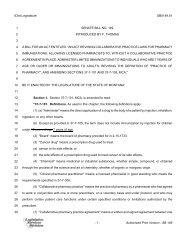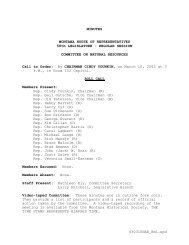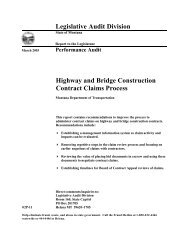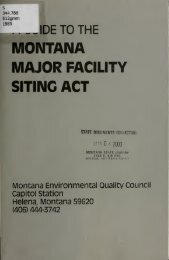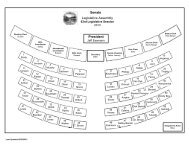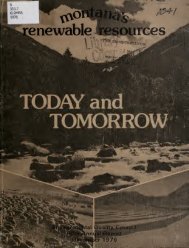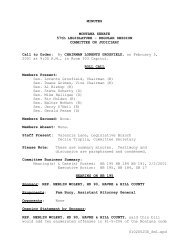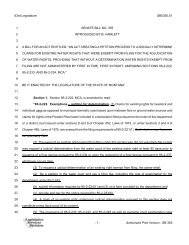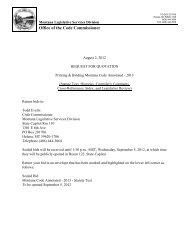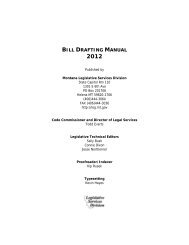Public Comment. Volume III - Montana Legislature
Public Comment. Volume III - Montana Legislature
Public Comment. Volume III - Montana Legislature
Create successful ePaper yourself
Turn your PDF publications into a flip-book with our unique Google optimized e-Paper software.
Vibration and Impact Studies<br />
Suggested Study Plan to Evaluate Potential Biological Impacts<br />
of Tongue River Railroad to the Miles City Fish Hatchery<br />
Background<br />
Tongue River Railroad Company (TRRC) is proposing to construct and operate a 120 mile<br />
railroad (TRR) that links into the existing Burlington Northern Santa Fe (BNSF) railroad at '<br />
Miles City and extends in a southerly direction along the Tongue River to Decker, <strong>Montana</strong>. The<br />
primary purpose of the link is to transport coal from the Tongue River coal region to electric<br />
power plants in the Midwest (Radian, 1998). With full development of mines in this area this<br />
will result in at least 12 train movements per day on the rail line (6 round trip coal trains). Every<br />
train will have approximately 1 13 coal cars that each carry 1 17 tons of coal (1 3,200 tons per<br />
train) (Radian, 1998)<br />
The proposed railroad will pass along the east side of the Miles City Fish Hatchery (MCFH).<br />
This hatchery is owned and operated by <strong>Montana</strong> Department of Fish, Wildlife and Parks (MT<br />
DFWP); hence the state of <strong>Montana</strong> must grant TRRC an easement to cross state lands. As a<br />
condition for granting an easement, MT DFWP will require studies to hlly identify impacts of<br />
the project, and will require full mitigation of these impacts.<br />
TRRC developed a study to assess the potential vibration effects of the TRR on hatchery<br />
operations (Womack and Associates- WAI - 1998). This study called for geotechnical analysis<br />
of soil types, movement and analysis of vibration, soil chemistry analysis, and evaluation of the<br />
potential effects of these factors on fish production. WAI conducted a literature review and<br />
consulted with fisheries experts regarding expected impacts. WAI also predicted vibration levels<br />
on-site and compared these with "threshold values" associated with adverse effects to fish. This<br />
report was received by the state in March of 1999.<br />
MT DFWP does not believe this study addressed all the potential project-related impacts<br />
(Bertellotti 1998, Peterson 1999). For example, WAI 's literature review contained studies that<br />
address avoidance responses of fish to vibrations, rather than the physiological effects on<br />
sensitive life stages and spawning and feeding behavior (Popper and Carlson 1998). This is<br />
because there is little, if any, existing information on vibration effects to fish in captive (closed<br />
system culture) situations where the fish are unable to avoid these conditions. In addition,<br />
studies &om this review, are not predictive of impacts to MCFH because of differences in<br />
species, physical environment, and processes associated with hatchery operations. WAIYstudy<br />
did not address vibration effects to egg/fry sunrival, forage species (plankton), feeding behavior,<br />
fish physiology, cumulative effects of elevated train traffic (Popper, personal communication,<br />
1999); or other potential impacts resulting from herbicide use, coal dust, interruption of water<br />
supplies, derailments, or other detrimental conditions that may occur. The lack of biological<br />
information beyond anecdotal references weakens the WAI study's applicability to the MCFH<br />
situation, and was the impetus for the inclusion of this study request.<br />
EQC Eminent Domain Study -235-



